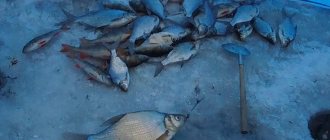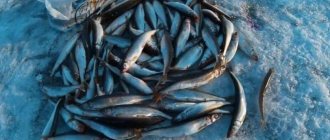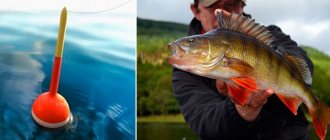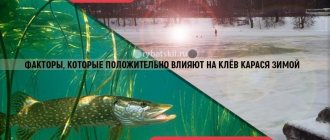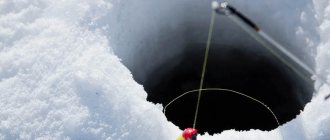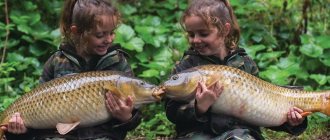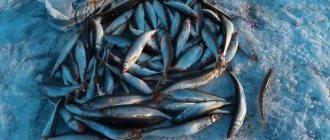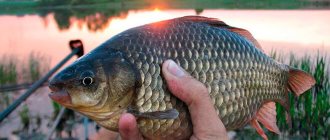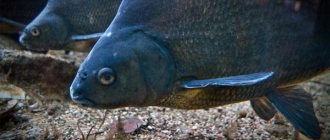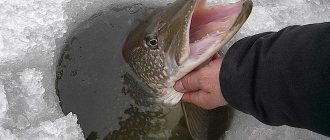Winter fishing on first ice
The first ice (also: first ice, first ice ) becomes a long-awaited and joyful event for many fishermen.
The start of ice fishing is preceded by a long and painstaking preparation of gear, equipment and additional accessories. Winter fishing has its own interesting and exciting moments. All the gear is close in front of your eyes, every touch of the fish is transmitted to the bite alarm. But for fishing to be successful, a special approach to preparing clothes, gear, and special accessories is required.
What you need to prepare for fishing on the first ice
Every fisherman knows: in order for fishing on the first ice to be successful, it is necessary to prepare for it in advance, as, indeed, for any other type of fishing.
What you should pay special attention to: 1. If possible, you need to take special equipment with you - a fishing navigator and echo sounder. This equipment will allow you to accurately determine the thickness of the ice and the topography of the bottom. Determining the topography of the bottom will allow you to determine the places where fish gather. It is best to carry out these manipulations in the summer, as all fishermen know. That by autumn most bodies of water become much shallower. 2. The use of echo sounders will make it possible to determine not only the topography of the bottom, but also the presence of all kinds of debris, stones, snags and other objects at the bottom. 3. There is a special device, fishermen call it an ice pick, which allows you to determine the thickness and strength of ice as accurately as possible.
If after one blow with an ice pick the ice breaks through, then it is better not to choose this place for fishing. If you ignore safety precautions when fishing on the first ice, you can not only get sick, but also die. By typing in Google winter fishing on the first ice, video, you can find a lot of useful videos, especially for beginners.
Many fishermen believe that fishing on the first ice is considered almost the most successful, the main thing is to choose the right place and time for fishing during the entire period of winter fishing.
Often fishermen make home videos about fishing, especially when there is a good bite. Such a video will leave a memory of a successful vacation for the rest of his life, not only for the fisherman himself, but also for all his relatives.
Experienced fishermen know that in winter the fish are especially shy, however, they are hungry and therefore take bait and food very well. It is also very convenient to fish on the first ice because the water during this period is especially clear and the fisherman can clearly see what is happening under the ice.
Preparation and Safety
The first ice, along with joy and good mood, also brings hidden danger to life and health to fishermen. No fish is worth the risk of falling through the ice. And if this happens at a depth of 1-1.5 m, then the person may get away with a cold. But if the ice does not hold up at a depth of more than 2 m or on a river with a current, then the fisherman’s life will be in the balance. And here a lot will depend on the efficiency of the person who failed, the availability of special devices, as well as on quick help from fellow hobbyists.
The main point when winter fishing on first ice is compliance with basic safety rules.
- You can plan fishing when the ice thickness is at least 7-10 cm. Even an ice shell of less thickness can withstand the weight of an adult, but on a reservoir, and especially on a river, the ice is not uniform.
- Fisherman's clothing should be light and comfortable. Then you will be able to group and avoid falling into the water.
- Every ice fishing enthusiast needs to have special devices in order to cling to the edge of the ice cover. These are ordinary awl-like tools with handles that are tied to a long rope. The device is passed through the sleeves of outerwear.
- To reach the first ice, it is preferable to take an ice pick rather than an ice screw. An ice pick is a large chisel attached to a long handle. With this tool you can test the strength of ice while moving through dangerous areas of the reservoir.
- It’s better to go to the first ice with a friend to protect each other.
Gear for fishing on the first ice and expected catch
Ice fishing requires completely different gear than open water fishing. Typically, fishermen use several types of fishing rods, which are selected depending on the type of intended catch.
Float rod
Winter float tackle most often consists of an ordinary filly fishing rod and float equipment
This classic ice fishing tackle is used to catch fish species such as:
The tackle is compact and convenient; it fits in a drawer or pocket. The float rod includes:
Fishing is carried out using natural baits. The most popular of them in winter fishing is the bloodworm. One or more larvae are attached to the jig hook. The bait sinks to the bottom, and the bite is determined by the float floating in the hole. The hook is performed by moving the hand. This is important, since the fishing line used on such a fishing rod is thin, 0.08-0.12 mm. The supply of fishing line is stored on a simple inertial reel with a small drum or on the handle of a fishing rod, which is made in the form of a reel.
Tackle with jig and nod
Fishing rods for jig fishing have a miniature size and a sensitive nod
This fishing rod is in many ways similar to float tackle. The main difference is the use of a nod instead of a float. However, the nod is needed not only to determine the bite, but also to give the jig an attractive game.
With such a fishing rod, anglers hunt for:
For fishing, you can use either a jig with a nozzle or a reelless one. When using a baitless jig, the intensity of the bite will depend on the performance of the artificial bait. To perform a retrieve that is attractive to fish, it is necessary to develop uniform movements with the same amplitude. This monotonous rhythm is most often liked by fish. A bite is determined by a failure in the movement of the nod.
Sheer trolling rod
Winter fishing rod (tackle) for vertical trolling and fishing on a balance beam
A trolling rod is used to catch predatory fish from the ice. It differs from jig tackle in a more powerful and longer rod, thick fishing line and the presence of a spinner. In winter they catch with this kind of tackle:
Vertical spoons and balancers are used as artificial bait. The larger the bait, the greater the likelihood of catching a large predator.
When trolling vertically, the angler makes sharp swings of his hand, throwing the lure up. After this there is a pause, and then the cycle repeats. When working monotonously with tackle, you should not relax. A blow from a predator often rips the fishing rod out of your hand.
You can determine the moment of a bite by nodding or a piece of nipple rubber placed on the tip of the rod. It is advisable to have a reel in such a fishing rod so that when hooking a large predator you can quickly give up part of the fishing line.
Winter girders
You can catch a predator in winter using girders. In winter, this type of gear is most often used to catch:
There are many varieties of girders, the principle of operation is similar for all.
- A 0.2-0.4 mm fishing line is wound onto a reel or reel, a sinker and a hook are attached.
- The tackle is placed motionless on the ice, the live bait is placed on a hook and lowered into the water.
- A bite alarm in the form of a spring and a flag holds the bait in the charged position.
- When a predator bites, the spring straightens, signaling the angler to “work.”
- The fisherman only needs to successfully land the fish on the ice.
On the first ice
Photo: Nikolay Linnik.
And at the same time, how many copies have been broken in the debate that if we discard the emotional component of the anticipation of the holiday, then the First Ice is simply an anachronism that came to us from the past.
The beauty of this period of time lies only in the fact that the labor costs for drilling holes are still very small, and on the ice shell of the reservoir there are areas completely untouched by competitors (it’s nice to be a pioneer!).
But, as is most often the case, the truth is somewhere in the middle.
I have repeatedly had the opportunity to encounter a magnificent fish bite, and to experience disappointment in laborious ice fishing, when in ten drilled holes you can see only one or two cautious bites.
Moreover, in recent years, labor fishing has happened more and more often.
They say this is due to increasingly mild winters.
I partly agree with this.
If the ice freezes in January, then you can no longer expect November (or even December) activity from the fish. However, if you follow certain rules, then you can still escape from complete zero and subsequent complete disappointment in ice fishing. This is what I want to talk about.
| Among winter baits, imitation nymphs occupy a special place. Photo: Nikolay Linnik. |
FASHIONABLE JIGS AND LURE DRIVING STYLE
It's no secret that on the eve of winter, every winter angler is trying to buy something new for his arsenal of baits. And this new one will definitely be one of the first jigs to “go under the ice” in the coming season.
Read the material “Behind roach and bream with a borer”
The choice of a specific bait is based on several criteria: advice from equally enthusiastic fellow fishermen and your own ideas when you simply like a jig.
And it’s good if the fisherman has sufficient experience and knows exactly what parameters of the jig he should pay attention to. And if not?
Then the first ice fishing trips can easily be overshadowed by the lack of bites.
It’s even worse when the neighbors are biting, and you’re participating in the crowd.
| Lures with contrasting colors attract perch well. Photo: Nikolay Linnik. |
For many years now, I have been starting my ice fishing trips with large jigs that are clearly visible and audible to the fish. What will be the main irritating factor (color, the presence of discs, cambrics or beads) will become clear during the fishing process.
Perhaps, due to circumstances, you will have to shift towards reducing the size of the jig. But for the first fishing trips, when neither the location of the fish nor its taste preferences are completely clear, it is best to start with clearly visible jigs, the working qualities of which are not in question.
Read the material “Out of Caliber”
I resort to experiments with baits in cases where the fish has indicated its presence under the hole, but it never came to a confident bite. For this case, I always have several fishing rods equipped with other jigs in my box.
By simply selecting bait, it is often possible to tempt even very capricious fish to bite.
| In winter, perch sometimes takes it from under the ice itself. Photo: Nikolay Linnik. |
Another unpleasant surprise when trying to open the season with a new jig can be its incorrect play. Each angler has his own fishing style, and a new bait simply may not fit into it.
In order not to end up with nothing, I advise you to postpone testing new jigs to a calmer period, when you have time to think and experiment.
For example, two weeks after the formation of ice, when the fish take up their usual winter stops, the factor of novelty in the game of bait will be almost the main element of success or failure of the entire fishing trip.
TACTICS FOR SEARCHING FOR ACTIVE FISH
A well-established stereotype, circulating from year to year in various periodicals, is the statement that during the period of first ice, schools of perch actively move across the water area of the reservoir and the fisherman who can calculate the trajectory of the fish and manage to get in its way will be the one with the catch.
Now imagine what the process of chasing fish might look like in practice. You move chaotically around the pond, drill many holes, and linger on each of them for a very short time.
Personally, I don’t really like this sporty style of fishing.
| Photo: Nikolay Linnik. |
Fishing will be much more productive if, having calculated the temporary location of the fish, you try to catch it with maximum benefit for yourself.
Read the material “Fishing in channels”
I like to open the ice season in the shallow grassy bays of large oxbow lakes, along gentle banks or around underwater rises. Due to the first ice, there is the greatest chance of running into a fattening predator.
And even if by the time I appear on the ice, many of these points will have been checked by other anglers - it doesn’t matter!
Firstly, it is not a fact that these were experienced “penguins” and they managed to greatly thin out the fish stock.
And secondly, in every body of water there are areas where fish visit periodically. So you need to check them constantly. But I try to avoid deep dives free of vegetation, as well as flooded bushes and tree trunks (which, by the way, are also often mentioned in publications) when perch fishing at this time.
There are no active perch on the first ice here. It will appear about two weeks after the ice forms.
| Photo: Nikolay Linnik. |
WHITE FISH DOESN'T BITE ON THE FIRST ICE?
Another persistent myth is the assertion that in the first days after ice formation, white fish are in shock and do not feed at all.
To find out if this is so, just try, as I once did, purposefully go to a pond for roach or bream. I'm sure you'll be pleasantly surprised. Moreover, in some reservoirs, white fish bite no worse, or even better, than striped ones.
Only the places where the leucorrhoea feeds are very different from the points where the predator feeds. So, if perch can most likely be found in shallow water, then roach and bream should be looked for along the dumps in depth.
Moreover, the most comfortable bite zone begins at 2.5 meters.
Read the material “About playing with a jig when catching roach”
And in recent years, in some reservoirs, roach and bream have generally become the main prime-ice fish, and I, having slightly changed the gear, with great pleasure devote the first two weeks of ice fishing to them.
| Perch is the main trophy when fishing from ice at the beginning of winter. Photo: Nikolay Linnik. |
Changes in gear for catching roach and perch are minor, but if you do not notice them, the desired result may not be achieved.
The main difference in my fishing rods for catching whitefish and predators is the nod. For white fish it is softer. Accordingly, lighter jigs are needed. So, if it is most convenient for me to catch perch with jigs weighing 0.33–0.35 g, then I catch roach and bream with jigs weighing 0.28–0.3 g.
After reading these lines, someone may object, because with a light jig at depth it is impossible to achieve the desired game. All this is true if we take perch high-frequency, large-amplitude jig play as a standard. But such a game is not needed for catching roach.
And in order not to break the style of wiring the bait, I decided to reduce its weight. It turns out that if the same (perch) parameters of working with the hand are observed, the final play of the jig becomes much softer, which is liked by roach and bream.
BEST FISH BITTING TIME
As we open the ice fishing season, each of us dreams of thoroughly enjoying catching trophy fish. But for many anglers, such fishing trips happen extremely rarely.
Only a few catch large fish regularly. The rest most often have to be content with catching “sailors” or last year’s roach. What is the problem?
I devoted several seasons to solving this problem and as a result came to the conclusion that the main reason for such differences in catches is the ability of the fisherman to be in the right place at the right time.
Read the material “Where and at whom can you shoot with a traumatic weapon”
Large fish feed periodically in summer, and in winter this feature of its behavior becomes dominant.
| In a successfully found place, the prey can be very significant. Photo: Nikolay Linnik. |
For example, two bursts of feeding activity are clearly visible in perch: in the morning, an hour before sunrise, and an hour and a half after it rises above the horizon, and also in the evening, about an hour and a half before dark. The rest of the time, the “sailors” remain active, which is what most anglers catch.
But for roaches and breams everything is different. The appetite of white fish awakens much later than that of predators.
The peak of feeding activity in the same roach occurs in the afternoon (from approximately 13:00 to 15:00). At other times, she seems to disappear from the pond.
| A compact fishing rod with a rigid whip allows you to quickly catch fish. Photo: Nikolay Linnik. |
As soon as I realized this, the tactics of fishing on the first ice changed a lot. From dawn I try to catch as many big bass as possible and fish the grassy shallows as well as areas around the underwater rises.
Then I go into the crowd and practice catching “sailors”.
Read the material “In the wilderness under the shore”
By midday, wanting to catch a large roach, I switch to fishing along deep drops.
By the way, this is one of the reasons that I like the evening time more than the morning. It is between 15:00 and 17:00 that large perches are caught as by-catch in roach holes.
As you can see, everything is not so complicated. My recommendations are simple, and I will be very happy if they bring you more bites from big fish.
Nikolay Linnik January 23, 2021 at 06:34
On the first ice should you go to the pond or to the river?
First of all, the ponds are covered with ice of 5-10 cm, which confidently holds a person, and only then the rivers
Ice fishing can be successful both on still bodies of water and on rivers. The difference lies in the methods of fishing and equipment of fishing rods.
In a pond, fish are evenly distributed throughout the water area. It can be caught under the shore, in the reeds, and in the depths. Since there is no current (or it is weak), the weight of jigs, sinkers and hooks is selected to a minimum. The tackle turns out to be elegant and sensitive. Fishing is possible at any time of winter, but the largest catches are on the first ice.
Fishing on the river is fraught with several difficult moments.
- As soon as sludge begins to actively float along the river, the fisherman should visit oxbow lakes and bays. This is where almost all types of fish flock. Active fishing continues until the river bed is completely covered in ice.
- After this the situation changes. Some representatives of the ichthyofauna return to the river, where they can be caught with different gear. Unlike lake fishing rods, river fishing gear looks more powerful and rougher.
- To resist the current, anglers have to use heavy jigs, sinkers, use stronger fishing line, etc. On some fast rivers, fishing can be short-lived, especially during warm winters.
Finding a fishing spot by first ice
Very often fish can be found exactly in those places where they were caught on a float or spinning rod from the shore in the water
An important point when fishing on the first ice is the correct choice of place. The fact is that after the ice cover is established, the fish get sick for some time. This is another compelling argument in favor of the later appearance of fishermen on the ice. Schools of fish occupy areas of the reservoir with favorable temperature and oxygen parameters of the water. The movements of fish in winter are quite slow and short. She saves the supply of nutrients accumulated in the fall and tries to feed near the chosen site.
Having found places where winter fish accumulate, you can hope for an excellent catch.
A week after freeze-up, acclimatization of underwater inhabitants occurs. At this time, there is an active bite of hungry perches, pikes and roaches.
The best places for fishing in early winter are:
- thickets of reeds and reeds;
- holes near the coastline;
- depth changes;
- shoal islands surrounded by deep areas;
- ditches and creeks;
- stuck areas.
When searching for a promising fishing spot, anglers usually make up to 10 holes in one direction. Moving with a fishing rod from hole to hole, not only the presence of fish is determined, but also the bottom topography.
Catching perch with balance beams - a hit parade of the most catchy lures and a guide to fishing techniques.
Perch with a jig - fishing technique, correct tackle and finding a fishing spot.
Winter pike with spoons - which spoons are catchy at the beginning of winter, and which ones in the dead of winter, we correctly find and catch the predator.
The first ice becomes an interesting and productive time when you can get an excellent fish bite. You just need to remember about safety precautions on thin ice, and also remember to release small and excess fish back into the reservoir. Then you will be able to enjoy excellent fishing at the beginning of winter more than once.
Fishing for pike and perch on the first ice
With the opening of the winter season, it makes sense to start catching predators. Pike bite most actively at times when there is ice only in bays and outskirts. This kind of fishing is quite dangerous, since the ice is very unreliable. On large bodies of water, when the ice thickness becomes safe, pike fishing does not stop, but fishing for pike perch, rotan and perch using a spoon becomes more interesting. Finding fish is quite easy, since you can drill holes one after another, while fishing entire areas.
Fishing tactics on thin ice are traditionally based on searching for fish at a pace. Namely, a quick survey of the fishing territory and fishing horizons.
The technique and tactics of catching such fish are significantly different from each other, having their own subtleties and features. Let's start with perch fishing. Immediately after ice appears, the perch settles in places with coastal vegetation, where the depth can be no more than one meter. Small perch are found in shallower places, a little more at a meter depth, and the largest perches are found on the border with vegetation during the daytime. Of course, they also approach the shore itself, but either in the early morning or only when the ice is completely covered with snow.
It is characteristic that in those areas where there is a sharp drop in depth straight from the shore and there is no vegetation, quite large perch remain almost throughout the entire winter. After freezing, medium and large perch stay in place for just a couple of days, then they move away from the vegetation zone closer to its border, to shallow places, after some time the perch goes to depth. In addition to places off the coast, you should look for perch on various underwater heights, on spits free of vegetation and on sharp drops into a hole.
At the moment, the tactics for finding perch are very simple. It consists of relatively fast movement in a certain direction along the underwater edge or along vegetation. In order to understand whether there is a fish under your hole, most often about three to five strokes of the spoon and several strokes of the balancer are enough, but if your balancer is large, the fish can indicate its presence much faster.
As a rule, it is possible to catch several perches this way. After the bite stops and the hole is completely exhausted, you should move to a new place and drill a hole and try there. As practice has shown, it is possible to return to the holes where there was successful fishing, but not earlier than three or four hours later, and even better not to waste your time on this at all. It is much more profitable to find a couple more places with active fish.
What kind of fish is caught on the first ice?
The first ice brings fishing on the first ice. It begins with the onset of cold weather on frozen bodies of water. Fishing is rarely unsuccessful. Before wintering, the fish have become hungry and greedily grab any bait. This period lasts approximately two weeks. At this time, in different regions of the country, you can catch the following fish with different gear:
A successful fisherman can catch both small bleak and large taimen, reaching a weight of 60 kg.
Fishing on the first ice - where to bite and what to fish for
Fishermen look forward to fishing during the first ice! Of course, because the bite at this time is wonderful, however, it does not last long - ten days, no more. By the time the “cool” time comes, a true fisherman must be “armed and dangerous” for the fish tribe.
The best place for fishing on the first ice:
- On the first ice, for trolling perch and pike, choose fishing spots near the cliffs in front of the holes;
- to catch ide on the first ice, look for a flat, deep stretch behind them;
- if at first the catchable places are in shallow water, near thickets of reeds, reeds, over flooded stumps and snags, then a little later - in deeper places, at the mouths of rivers, places where springs emerge.
- in shallow places it is useless to fish without camouflage; you need to at least lay out a raincoat and fish from it.
When it bites on the first ice:
- perch feeds early in the morning and from 15:00;
- burbot begins to bite at nightfall;
- ruffe can be caught on the first ice around the clock;
- Consequently, fish bite on the first ice all day long, but at different times.
What to fish with on the first ice:
- the most catchy jigs are pear-shaped or lentil-shaped with hook No. 6 - 8;
- for catching perch (both with a spoon and a jig), the best bait is a small fish, even a slightly dented one;
- a bunch of bloodworms (5 - 7 pieces) on a jig hook is irresistible for ide, bream, and pike perch.
- perch, roach, and silver bream prefer no more than 2 bloodworms strung on a hook in a ring; these fish, especially perch, like it when the bait is moving.
How to find fish sites at the beginning of winter
Fishing at the beginning of winter is characterized by increased bite. But the ice cover at this time is thin and weak. It prevents you from getting closer to the point of a successful catch. On small lakes and ponds, ice cover grows faster than on rivers with flow. Winter fishing on first ice begins near coastal areas and creeks, protected from the winds. There the first layer of strong cover appears.
But the fish do not like these places and are looking for warmer water. She chooses a place on the border between ice areas and open water. In this place the ice is thin and you can easily fall under it.
You can look for fish sites in snags, near a wall of reeds, on the edge of dark ice. For this purpose, you will have to drill many holes and use different fishing gear. If the fish does not bite within two or three casts of the gear, it is recommended to make an ice hole in another place. This is the only way to find a good fishing spot.
When searching for a fishing spot, you should avoid dangerous areas, which include:
- stream mouths;
- places with protruding vegetation;
- places with fast currents.
It's better to stay in shallow water than to get caught in the ice. While searching, you can use an echo sounder, which will show the presence and depth of fish.
Preparing for fishing on first ice
First Ice is a joyful and long-awaited event. You need to be well prepared for it. It is necessary to check clothing and shoes, gear and accessories. When going out on thin ice, you must follow safety rules.
Safety precautions
When fishing, unpleasant incidents often happen that cannot be justified by any catch. You should go fishing when the ice thickness is 7-10 cm and wear comfortable clothes. You need to have an awl or a knife or an ice pick tied to you.
Gear for fishing on the first ice and expected catch
Fishing gear should be light in weight. These can be different spinners or a balancer. The best lure is homemade. Over time it is brought to perfection. At shallow depths, a vertical spinner works well.
To catch small fish, jig tackle and a fishing rod with a nod are used. It is also used when fishing for perch. First ice is the time to use various fishing gear.
Float rod
Ice fishing requires the use of several fishing rods. Not the last place among them is the float. It consists of equipment and a filly, has a compact size, and can even fit in your pocket. The gear is used for catching bream, roach, silver bream, gudgeon, perch, and ruffe. Fishing on the first ice uses natural bait and groundbait.
Groundbait in the form of bloodworms is very common. You need to put 1-3 larvae on the hook and lower it into the water. The bite is determined by the float that floats in the hole. A hook is made with the hand.
A fishing line with a thickness of 0.08-0.12 mm is wound onto a reel located on the fishing rod. Float fishing on the first ice can bring prey in the form of large fish.
Tackle with jig and nod
In winter, jigs and nods are often used. This fishing rod looks like a float rod. The only difference is the nod, which is used instead of a float. The nod is not just a bite signal, it gives the jig additional movement. The fishing rod is used on the first ice when fishing for perch, bleak, roach, silver bream, and white bream.
The jig can be attached or unattached. The result of fishing is influenced only by the play of the jig.
Sheer trolling rod
Fishing on the first ice is also done using vertical lures. For this, a balancer or a spinner is used. The fishing rod has a longer rod and thicker line. The tackle is intended for catching trout, pike perch, perch, pike, and bream. The bait is spoons or a balancer. A large spoon can be used to catch a large predator.
When flashing, sharp swings of the hand are made. As a result, the spoon takes off from the depths and falls again. The moment of the bite is determined by the behavior of the nod. It is advisable to equip the fishing rod with a reel so that at the right time you can give the fishing line or part of it to the predator.
Winter girders
The predator is also caught using girders in winter. Pike, perch, pike perch, burbot, trout and other fish species bite on them. All available types of vents have the same operating principle. A fishing line with a thickness of 0.2-0.4 mm is wound onto the reel. A hook and sinker is attached to the end of the line. The tackle is installed on the hole, the live bait on the hook is lowered into the water. A flag serves as a bite signal. The fisherman can only wait and fish out the catch from the ice hole. You can equip the vent with your own hands and for free.
Fishing for perch on the first ice
On first ice, perch actively moves throughout the reservoir in search of food, so it actively bites. For such fish, light tackle with a sensitive nod is used. The fishing rod should be compact (up to 20 cm in length), have a comfortable handle and a small reel. For fishing line, it is preferable to use monofilament 0.12–0.25 mm in diameter and 10 m long. At this time, you can catch large fish, so take a thicker fishing line with a breaking strength of 2–3 kg.
When fishing for perch, the sensitivity of the nod is very important, so experienced fishermen sometimes make it themselves or purchase it from a fishing store. The main thing is that the nod reacts to any bites of this cunning fish.
Successful fishing for perch on the first ice is unrealistic without an accurate selection of baits. At this time, they use jigs, spinners and balance beams, although some fishermen believe that during the feeding period, perch rushes at everything that moves under water.
For successful fishing, it is very important to choose the right color and size of bait. Some people believe that large fish are better caught using a balance beam and a spoon.
Where does the fish bite better on the first ice?
Fish bite on the first ice in any body of water. This could be a lake, pond or river. As the ice thickness increases, the perch sinks to the rough surface. It lives on the borders of ice and clean water, in algae. Perch hunts in large schools in the morning and evening. You can catch up to 10 pieces from one hole. The bait is small fish.
Burbot on the first ice is caught after the ice reaches a thickness of 10 cm. This must be done near the shore using a spoon. The most active bite begins in the evening. The bait is caught in the same reservoir.
River with current
Fishing before the first ice is more dangerous, because it is not uniform. With a strong current, eddies are formed and the ice becomes thinner. It's hard to notice with the eye. If you fail, you can easily fall under the ice. For fishing use:
- jigs with a nod;
- balancers;
- vertical spinners;
- float rods with a nod;
- microjig;
- winter girders.
These gears work effectively on rivers with currents. When working with baits, you need to have different types. The peculiarities of ice fishing on the river are such that successful fishing will leave pleasant memories in your memory.
Pond with standing water
In the pond, fish are observed to be dispersed throughout the water area of the reservoir. It can be caught in the reeds, close to the shore, at great depths. In the reservoirs of lakes and ponds, fish are caught all winter. But the most active bite occurs on the first cover. Jigs, hooks and sinkers need to be light, because there is no current. The most successful places are in bays and oxbow lakes. After complete icing, the fish leave these places for the rivers, where they can be caught with a jig; fishing can also be done with other gear.
Where to fish on the first ice - where to look for fish
If you are a beginner and are going fishing on the first ice for the first time, experienced fishermen advise looking for fish in certain places. If we don’t find fish under the shore, we should go to the dump in the depths, study the riverbed or sit in the bay. But in this case, we have a limited area in which to search.
On many spring-fed lakes and rivers, ice edges appear only in some places. Ice formation begins in creeks, in low-wind areas and along the shores of small bays.
It happens that fish leave these places because near the shores, under the ice crust, the temperature is a couple of degrees lower than in open areas. However, fish are attracted to such places near the coast, mainly due to the large accumulation of food, for example, in fallen leaves or flooded bushes, various invertebrates find their refuge. Also, some species of fish constantly stay not far from the shore, while others spend most of their time on the border of ice and open water, periodically making forays to the shore.
With the appearance of edges, on small rivers, fish tend to be closer to the shore in search of food. If a fish, feeding near the shore, senses the slightest danger, it will immediately leave, either to the stream or to the riverbed.
Larger fish behave much more cautiously, being in places on the border of the stream and calm water. Such individuals approach closer to the shore or in the late evening at dusk or early in the morning. In addition, it is very appropriate to look for large fish in places with matte ice, where the fish will not be frightened by the shadow of an angler walking on the ice. In search of trophies, you should walk on the ice as quietly as possible, reducing noise to a minimum.
When fishing in the current, the first bites usually occur at the very beginning, when, studying the depth in a chosen place, you slowly lower the bait to the bottom.
Under the influence of the current, jigs with characteristically pronounced bevels and edges begin to play, and at this moment the fish begins to react to the movement by biting. During the period of first ice, many fish like to be at the junction of light and dark areas, in a place where the border of light and matte ice is clearly visible. And if the ice is dark, all along the edges, then you should look for fish closer to open water. It is worth considering that fishing on ice near open water is quite unsafe; in such a place it is better to fish together so that you can help each other in various cases.
Dark areas of ice that do not allow intense light to pass through are good shelter for both predators and various small creatures.
A little about security
Some anglers rule out the possibility of getting into cold water in winter. But tragedy can happen in the most unexpected and trivial situations.
An indicative example is the ice hole made recently by fishermen, which was covered with a thin ice crust and masked with fresh snow. The most careful person can get into it. Even at shallow depths, serious problems can arise, since it is difficult to get out on the ice on your own in heavy clothing. Experienced fishermen always take with them a simple device called “Rescuers”. It consists of two awls with comfortable handles, which are connected to each other with a nylon rope. They hide in the sleeves of a winter jacket and, if necessary, quickly end up in your hands. With the help of sharp “Rescuers” you can dig into the ice and pull the body onto the ice.
Methods of fishing on first ice
You can fish on the first ice with different gear. The most popular methods are the following.
- Sheer trolling is a fairly safe and mobile fishing option. Armed with an ice pick, you can slowly move across a frozen body of water. The holes are made quickly with an ice pick in thin ice. You can get a lot of perches from one successful hole with a spoon. There is good fishing with artificial baits for pike perch.
Photo 2. Winter lure.
Photo 3. Jig fishing rod.
Photo 4. Pike vent.
Fish Search Tactics
In different bodies of water, after freeze-up, fish occupy certain water areas. Much depends on the size of the reservoir, as well as on the behavior of a particular species.
- The easiest way to find active fish is in ponds, oxbow lakes, and small lakes. Within a few hours you can explore the reservoir up and down. If the fish is feeding, then you won’t have to wait long for a bite. First, you should study the coastal areas, and then look for fish in the depths.
- It is more difficult to find a decent trophy on large rivers and reservoirs. Large areas will require both means of transportation and instruments for determining depth. In this case, you should start from the type of fish that is being hunted.
One of the coveted winter trophies among jig fans is bream. Fishing on the first ice is the best period for catching large fish. At the beginning of winter, schools of bream and bream occupy deep holes. It is futile to look for this fish at a depth of 6 m. Of particular interest to the bream angler are sudden changes in depth. It is on the dump that it is more convenient for bream to feed without expending a lot of energy. Since it is difficult to lure a school with bait during the period of first ice, the fisherman simply needs to move along the edge.
Pike and perch
In winter, pike and perch stick to the same parking areas. This is explained by the fact that these predators hunt for the same linen. After the ice freezes, they chase schools of bleak or roach in shallow areas of the reservoir. Therefore, the search starts from the coastline. Often bites from perch or pike occur right off the shore or in the grass. The fishing depth should not exceed 4 m, but the choice of gear depends on the size of the population of each species. If there are a lot of these predators in a particular body of water, then you can catch them using vertical trolling.
But when there are a few toothy fish in the lake, it is better to set up fishing rods with the usual live bait, and hunt for perch with a spinner or a balance beam. The largest humpback whales can be caught in rocky areas or snags.
Content
- Consistently first
- Rotan Hunter
- Skiing on ice
- In search of the "Queen of Pike"
- How was your first ice fishing this season?
Autumn frosts are long-awaited for those fishermen who can’t wait to open the “hard water” season. As soon as ice 2-3 centimeters thick appears, the first “adventurers” come to the surface of the reservoirs, and the next day in the “news from the reservoirs” section they publish notes with the headings “Fishing on the first ice 2017-2018.” We present to you a selection of news in which the authors share their impressions of their first ice fishing, and tell where and what they caught.
